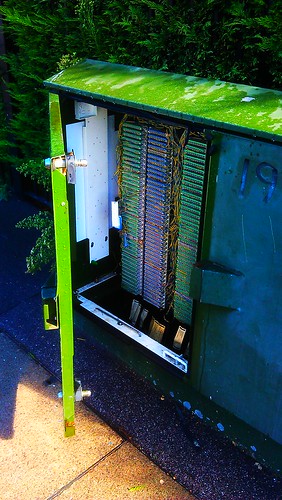I know Vodafone's got too much cash these days, but I think they missed a trick here. I can't count the number of times per day that I have to dodge inattentive people on the streets, due to the distraction of naughty texts, Facebook selfies, or YouTube videos of cats playing piano, and I wonder how many unnecessary injuries and physical altercations occur as a result of this sort of scenario. Beer companies don't glorify their product by showing humourous scenes of drunk drivers killing people irresponsibly, so why should Yoda step in to salvage an antisocial hipster behaving stupidly with a Vodafone device? The company could have saved itself some considerable expense by just letting the kid on the scooter head-butt him in the genitals at full speed. I would respect that. Might even tempt me to join Vodafone. Out of contract, I am.
Monday, September 16, 2013
Saturday, September 07, 2013
Misadventures in asset management

This is a BT street cabinet on Townley Road, East Dulwich. It's been open at least five days. Luckily, it appears that the copper thieves we hear so much about haven't ravaged it yet. It's on a stretch of pavement that sees a lot of traffic from school kids, so it's sort of surprising that a curious child, or one with vandalous tendencies, hasn't yanked out a fistful of phone lines. There's a VDSL cabinet a few metres away, so I'm guessing the engineer did some provisioning and forgot to lock up.
Makes me wonder why the M2M brigade haven't created a simple GSM-enabled device with a light meter, which could report hourly. Three consecutive hourly reports of ambient light above a certain threshold could generate a flag to alert the asset management team that the cabinet is most likely open, and a truck roll could be organised.
Another approach could be crowdsourcing. Find two or three dependable people in each urban postcode to walk a designated route covering a number of cabinets every day or so, and report problems, in exchange for free service. Like a kind of broadband neighbourhood watch.
Or just set up a Twitter account, like @OpenBTcabinets.
That is, if anyone cares...
Wednesday, September 04, 2013
Adventures in Cambodian overhead cabling
Apologies, vestigial mega-uber value readers, for my ongoing lack of output. As usual, I'm involved in some very interesting stuff, which I can't really talk about. What I can share is that I've been doing some consultancy work with a company in Cambodia, and I've observed and photographed the most surreal cabling "solutions" I've ever seen. I wish I'd taken more photos to share with you, but after a couple of days there, the massive snarls of (mostly) fiber overhead become a commonplace sight, and my eye is drawn to all the other amazing sights in this fascinating place.
If you look closely at some of these photos, you'll see PON splitter enclosures, which almost certainly serve customers of one of Phnom Penh's FTTH operators. Yes, you heard me right, FTTH in Phnom Penh, capital of a country where many people earn less than $100 per month. It's a niche product, however, targeted at affluent locals and the burgeoning ex-pat community. How do you fancy paying $225 per month for 4Mbps? Not a power user? How about $115 for 2Mbps? Granted, IP transit is expensive in Cambodia, because of the absence of an undersea cable landing (though that's going to change, and it will be interesting to see how pricing/demand moves in the aftermath), but I think we can guess what the margins must be on these products with pricing like that. This is an interesting conundrum, wherein a superior technology is throttled back to keep opex low, and also to avoid taking the market beyond where it is "ready" to go. I don't mean that Cambodians wouldn't love 1Gbps connections today, but if 512k/1Mbps is the current benchmark, then I assume the commercial guys would question why an operator should force things to evolve dramatically faster than the market really demands?
If you look closely at some of these photos, you'll see PON splitter enclosures, which almost certainly serve customers of one of Phnom Penh's FTTH operators. Yes, you heard me right, FTTH in Phnom Penh, capital of a country where many people earn less than $100 per month. It's a niche product, however, targeted at affluent locals and the burgeoning ex-pat community. How do you fancy paying $225 per month for 4Mbps? Not a power user? How about $115 for 2Mbps? Granted, IP transit is expensive in Cambodia, because of the absence of an undersea cable landing (though that's going to change, and it will be interesting to see how pricing/demand moves in the aftermath), but I think we can guess what the margins must be on these products with pricing like that. This is an interesting conundrum, wherein a superior technology is throttled back to keep opex low, and also to avoid taking the market beyond where it is "ready" to go. I don't mean that Cambodians wouldn't love 1Gbps connections today, but if 512k/1Mbps is the current benchmark, then I assume the commercial guys would question why an operator should force things to evolve dramatically faster than the market really demands?
Subscribe to:
Comments (Atom)
